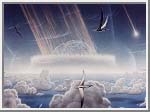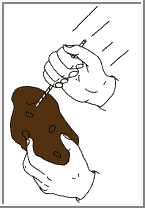 Meteoroids and Space Debris Activity
Meteoroids and Space Debris Activity
Meteoroids and space debris present a potential hazard to astronauts and spacecraft.
This activity demonstrates the penetrating power of a projectile with little mass
but with high velocity.
| Procedure |
|---|
| Materials Needed:
Raw potato
Large-diameter plastic straw
|
Step 1. Hold a raw potato in one hand. While grasping the
straw with the other hand, stab the potato with a quick, sharp motion. The straw
should penetrate completely through the potato. Caution: Be careful
not to strike your hand.
|
Step 2. Again hold the potato and this time
stab it with the straw using a slow push. The straw should bend before penetrating
the potato very deeply.
|
 Astronauts on spacewalks are likely to encounter fast-moving rocky particles called meteoroids.
A meteoroid can be very large with a mass of several thousand metric tons, or it can
be very small--a micrometeoroid about the size of a grain of sand. Every day Earth's atmosphere
is struck by hundreds of thousands or even millions of meteoroids, but most never
reach the surface because they are vaporized by the intense heat generated when they rub
against the atmosphere. It is rare for a meteoroid to be large enough to survive the descent
through the atmosphere and reach solid Earth. If it does,
it is called a meteorite.
Astronauts on spacewalks are likely to encounter fast-moving rocky particles called meteoroids.
A meteoroid can be very large with a mass of several thousand metric tons, or it can
be very small--a micrometeoroid about the size of a grain of sand. Every day Earth's atmosphere
is struck by hundreds of thousands or even millions of meteoroids, but most never
reach the surface because they are vaporized by the intense heat generated when they rub
against the atmosphere. It is rare for a meteoroid to be large enough to survive the descent
through the atmosphere and reach solid Earth. If it does,
it is called a meteorite.
In space there is no blanket of atmosphere to protect spacecraft from the full force of
meteoroids. It was once believed that meteoroids traveling at velocities averaging 80 kilometers
per second would prove a great hazard to spacecraft. However, scientific satellites with
meteoroid detection devices proved that the hazard was minimal. It was learned that the
majority of meteoroids are too small to penetrate the hull of spacecraft. Their impacts
primarily cause pitting and sandblasting of the covering surface.
Of greater concern to spacecraft engineers is a relatively recent problem--spacecraft debris.
Thousands of space launches have deposited many fragments of launch vehicles, paint
chips, and other "space trash" in orbit. Most particles are small, but traveling at speeds of
nearly 30,000 kilometers per hour, they could be a significant hazard to spacecraft and to
astronauts outside spacecraft on extravehicular activities.
Engineers have protected spacecraft from micrometeoroids and space trash in a number of
ways, including construction of double-walled shields. The outer wall, constructed of foil
and hydrocarbon materials, disintegrates the striking object into harmless gas that
disperses on the second wall. Spacesuits provide impact protection through various
fabric-layer combinations and strategically placed rigid materials.
Although effective for particles of small mass, these protective strategies do little if the
particle is large. It is especially important for spacewalking astronauts to-be careful when
they repair satellites or do assembly jobs in orbit. A lost bolt or nut could damage a future
space mission through an accidental collision.
Additional Demonstration on Meteoroids and Space Debris:
Aim a pea shooter at a piece of tissue
paper taped to a cardboard frame. Aim
the shooter at the tissue paper and blow
hard into the shooter to accelerate the pea
to the tissue at a high velocity. Drop the
pea on to the tissue paper from a height of
two meters. In the first demonstration the
pea will penetrate the tissue, but in the
second the pea will bounce.
| 












